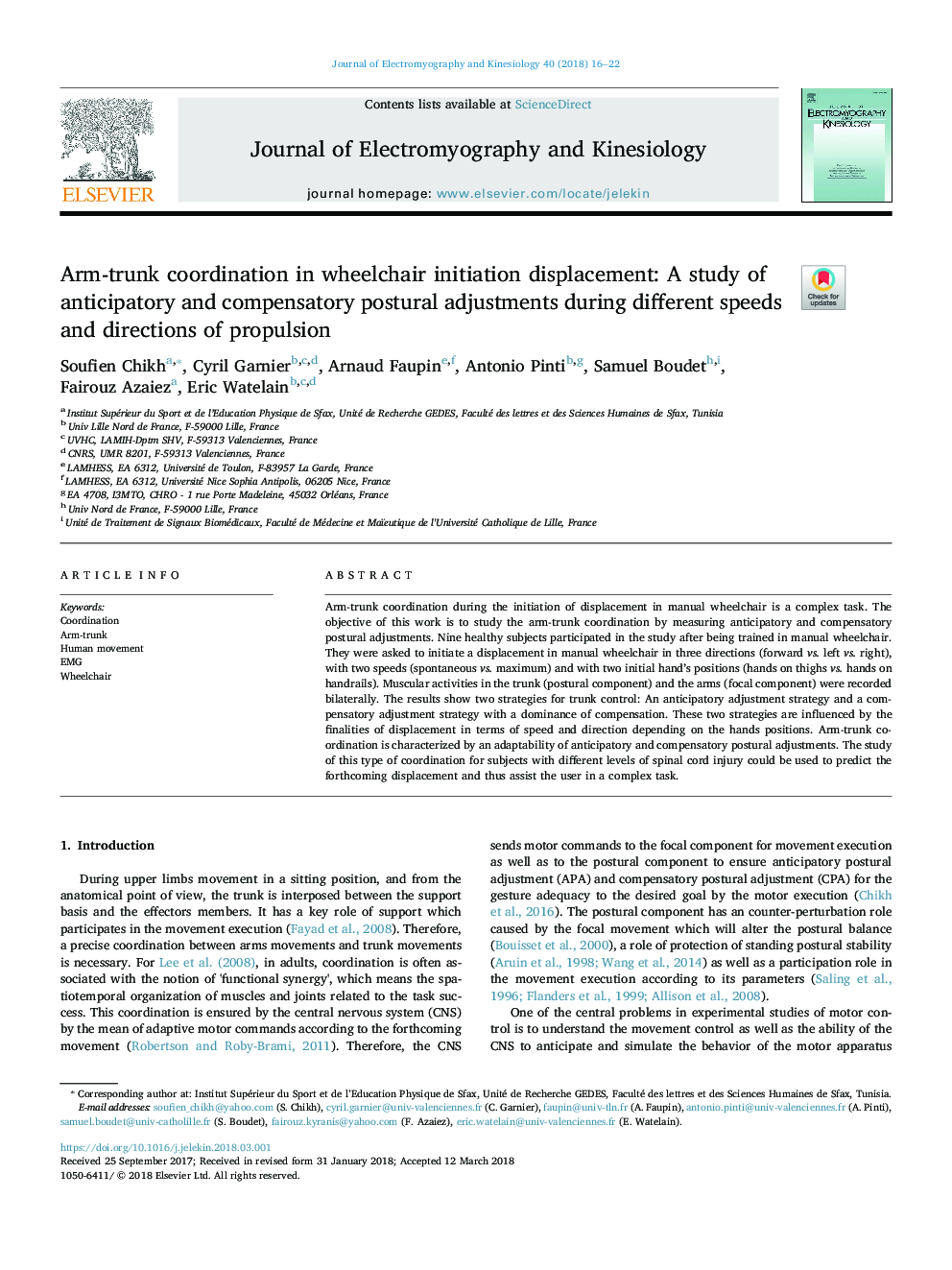| کد مقاله | کد نشریه | سال انتشار | مقاله انگلیسی | نسخه تمام متن |
|---|---|---|---|---|
| 8799770 | 1604173 | 2018 | 7 صفحه PDF | دانلود رایگان |
عنوان انگلیسی مقاله ISI
Arm-trunk coordination in wheelchair initiation displacement: A study of anticipatory and compensatory postural adjustments during different speeds and directions of propulsion
ترجمه فارسی عنوان
هماهنگی بازوهای تنه در جابجایی آغازین صندلی چرخدار: مطالعه پیش تنظیم و جبران تنظیمات ظاهری در سرعت های مختلف و جهت نیروی محرکه
دانلود مقاله + سفارش ترجمه
دانلود مقاله ISI انگلیسی
رایگان برای ایرانیان
کلمات کلیدی
ترجمه چکیده
هماهنگی مجدد تنه در هنگام جابجایی در صندلی چرخدار دستی یک کار پیچیده است. هدف از این کار، بررسی هماهنگی بازو تنه با اندازه گیری تنظیمات پیش بینی شده و جبران پذیری موضعی است. پس از آموزش در صندلی چرخدار دستی، نه فرد سالم در این مطالعه شرکت کردند. از آنها خواسته شد که در صندلی چرخدار دستی در سه جهت (پیش رو در مقابل سمت چپ در مقابل راست)، با دو سرعت (خود به خودی در برابر حداکثر) و دو موقعیت دست اول دست (دست بر روی ران در مقابل دست بر روی حاشیه) ایجاد شود. فعالیت های عضلانی در تنه (عنصر موضعی) و بازو (مولفه کانونی) به صورت دو طرفه ثبت شد. نتایج نشان می دهد که دو استراتژی برای کنترل تنه: یک استراتژی تنظیم پیش بینی و یک استراتژی تعدیل جبرانی با غلبه بر جبران خسارت. این دو استراتژی تحت تأثیر نهایی جابه جایی از لحاظ سرعت و جهت بسته به موقعیت های دست تحت تاثیر قرار می گیرد. هماهنگی تنه تنشی با سازگاری تنظیمات پیش بینی شده و جبران پذیری موضعی مشخص می شود. مطالعه این نوع هماهنگی برای افرادی که دارای ضایعات نخاعی مختلف هستند می تواند برای پیش بینی جابجایی آینده استفاده شود و در نتیجه به کاربر در یک کار پیچیده کمک می کند.
موضوعات مرتبط
علوم پزشکی و سلامت
پزشکی و دندانپزشکی
ارتوپدی، پزشکی ورزشی و توانبخشی
چکیده انگلیسی
Arm-trunk coordination during the initiation of displacement in manual wheelchair is a complex task. The objective of this work is to study the arm-trunk coordination by measuring anticipatory and compensatory postural adjustments. Nine healthy subjects participated in the study after being trained in manual wheelchair. They were asked to initiate a displacement in manual wheelchair in three directions (forward vs. left vs. right), with two speeds (spontaneous vs. maximum) and with two initial hand's positions (hands on thighs vs. hands on handrails). Muscular activities in the trunk (postural component) and the arms (focal component) were recorded bilaterally. The results show two strategies for trunk control: An anticipatory adjustment strategy and a compensatory adjustment strategy with a dominance of compensation. These two strategies are influenced by the finalities of displacement in terms of speed and direction depending on the hands positions. Arm-trunk coordination is characterized by an adaptability of anticipatory and compensatory postural adjustments. The study of this type of coordination for subjects with different levels of spinal cord injury could be used to predict the forthcoming displacement and thus assist the user in a complex task.
ناشر
Database: Elsevier - ScienceDirect (ساینس دایرکت)
Journal: Journal of Electromyography and Kinesiology - Volume 40, June 2018, Pages 16-22
Journal: Journal of Electromyography and Kinesiology - Volume 40, June 2018, Pages 16-22
نویسندگان
Soufien Chikh, Cyril Garnier, Arnaud Faupin, Antonio Pinti, Samuel Boudet, Fairouz Azaiez, Eric Watelain,
